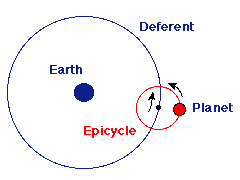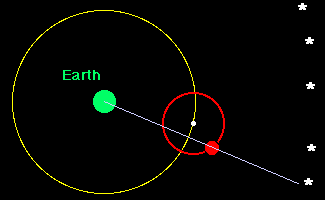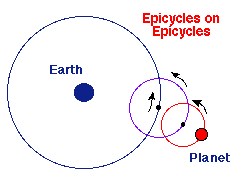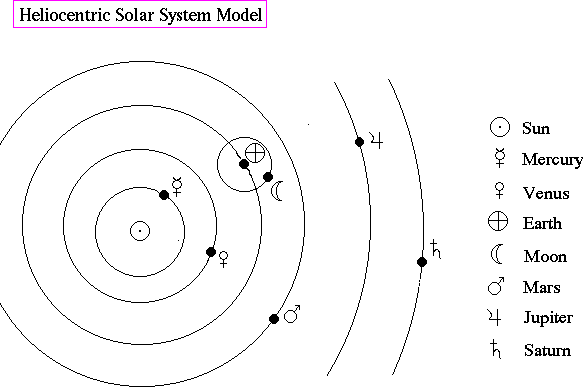

In order to preserve the geocentric cosmology of the time and to account
for retrograde motion of Mars, Ptolemy had to make a model of planetary
motion that invoked the use of epicycles. An epicycle is basically a little
"wheel" that orbits on a bigger wheel.
The use of epicycles as a desperate attempt to preserve geocentric cosmology
makes the orbits of planets very complicated and violates the scientific
search for simplicity.

The net
effect was as illustrated in the following animation. As the center of the
epicycle moves around the deferent at constant angular velocity, the planet
moves around the epicycle, also at constant angular velocity. The apparent
position of the planet on the celestial sphere at each time is indicated by the
line drawn from the earth through the planet and projected onto the celestial
sphere. The resulting apparent path against the background stars is indicated
by the
blue line.
Now, in this tortured model one sees that it is possible to have retrograde
motion and varying brightness, since at times as viewed from the earth the
planet can appear to move "backward" on the celestial sphere. Obviously,
the distance
of the planet from the Earth also varies with time, which leads to variations
in brightness.
Thus, the idea of uniform
circular motion is saved (at least in some sense) by this scheme, and it allows
a description of retrograde motion and varying planetary brightness.
The main problem, is that a single epicycle does not really quantitatively
account for the observed 83 days of retrograde motion, every 786 days for Mars.
Therefore ...
Epicycles and Planetary Motion
 In the (nutso) model of Ptolemy, planets were attached, not to the concentric spheres themselves, but
two circles attached to the concentric spheres, as illustrated in the adjacent
diagram. These circles were called "Epicycles",
and the concentric spheres to
which they were attached were termed the "Deferents". Then, the centers of the
epicycles executed uniform circular motion as they went around the deferent at
uniform angular velocity, and at the same time the epicyles (to which the
planets were attached) executed their own uniform circular motion.
In the (nutso) model of Ptolemy, planets were attached, not to the concentric spheres themselves, but
two circles attached to the concentric spheres, as illustrated in the adjacent
diagram. These circles were called "Epicycles",
and the concentric spheres to
which they were attached were termed the "Deferents". Then, the centers of the
epicycles executed uniform circular motion as they went around the deferent at
uniform angular velocity, and at the same time the epicyles (to which the
planets were attached) executed their own uniform circular motion.

 More Sophisticated Epicycles are required!
More Sophisticated Epicycles are required!
 In practice, even this convoluted epicycle model was not enough to account for the detailed
motion of the planets on the celestial sphere! In more sophisticated epicycle
models further "refinements" were introduced:
In practice, even this convoluted epicycle model was not enough to account for the detailed
motion of the planets on the celestial sphere! In more sophisticated epicycle
models further "refinements" were introduced:
The fact that ancient astronomers could convince themselves that this elaborate scheme still corresponded to "uniform circular motion" is testament to the power of three ideas that we now know to be completely wrong.
The Ptolemaic Moment will stand for about 1500 years with this model for planetary orbits remains unchallenged, partly because Ptolemy's model did improve the precision to which planetary positions could be predicted. Remember, however, the precision at measuring planetary positions was quite poor and therefore there was a large random error involved when comparing predictions with observations. So early Astronomers could propose models like these without accurate observations to check the predictability.
 The Ptolemaic model represents an excellent example of "cultural" bias
in science. Most citizens of the culture wanted to accept the idea of
the Earth being the center of the Universe (i.e. the earth was special)
and therefore observations were molded in such a way so as to preserve
that cultural norm. (Things may not be very different today). Furthermore, it
was to the benefit of early christian church to support an Earth-centered
universe because it gave humanity significance (something that people needed living in harsh
times) along with a Prime-Mover God. This in turn gave
the church enormous influence and power over the people.
By removing Earth from the center of the Universe and attributing interactions
to randomness (Democritus), humans have less significance in the Cosmos and the
church holds less sway over the people.
The church wasn't going to let this happen without a fight as Galileo found out.
The Ptolemaic model represents an excellent example of "cultural" bias
in science. Most citizens of the culture wanted to accept the idea of
the Earth being the center of the Universe (i.e. the earth was special)
and therefore observations were molded in such a way so as to preserve
that cultural norm. (Things may not be very different today). Furthermore, it
was to the benefit of early christian church to support an Earth-centered
universe because it gave humanity significance (something that people needed living in harsh
times) along with a Prime-Mover God. This in turn gave
the church enormous influence and power over the people.
By removing Earth from the center of the Universe and attributing interactions
to randomness (Democritus), humans have less significance in the Cosmos and the
church holds less sway over the people.
The church wasn't going to let this happen without a fight as Galileo found out.
Recall, there was a competing model of the time, that of Aristarchus of Samos (280 BC):
Aristarchus of Samos (c. 310-230 BC), Greek astronomer, first to maintain that the Earth rotates and revolves around the Sun. On this ground, Cleanthes the Stoic declared that he ought to be indicted for impiety.
Aristarchus' advanced ideas on the movement of the Earth are known from Archimedes and Plutarch; his only extant work is a short treatise, "On the Sizes and Distances of the Sun and Moon." The values he obtained, by using geometry, are inaccurate, because of faulty observations. Aristarchus found a more precise value for the length of the solar year.)


Aristarchus was extremely clever and also figured out a way to determine the ratio of distances between the earth and the moon and the earth and the sun. While wrong, at least he reasoned that the sun was much farther from the earth than the moon.